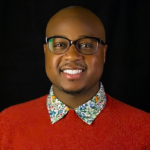From the NCTE LGBTQ Advisory Committee
This blog post was written by LaMar Timmons-Long, a member of the NCTE LGBTQ Advisory Committee.
In schools across the country, there are outstanding and brilliant students who identify as Black queer youth. This group includes students with various ages, experiences, and identities, including lesbian, gay, bisexual, transgender, queer, cisgender, and nongender-conforming. Besides being Black, which in itself is a dynamic way of being, to be Black, young and queer is a gift to the world.
Black queer people’s stories are an essential part of the foundation of this world. Yet throughout many classrooms, the stories of Black queer students are not considered or told. When you are Black and queer, you are placed in a box in which you are a part of multiple marginalized groups. The world tells you that your way of life is wrong, that you do not belong, and that you are not important.
Imagine what this might feel like, trapped in this box, being condemned for how you love. Unfortunately schools are often places where Black queer youth are denied their humanity in this way, and the time to put an end to this way of thinking is now.
In April 2019 I had the pleasure of attending the first Annual National Antiracist Book Festival at American University in Washington DC. The session on Queering Blackness featuring the authors Michael Arceneaux and Darnell L. Moore was a life- and game-changer.
I sat there wide open and ready to hear from these two magnificent Black queer authors whose lives have shaped their writing and their lenses on the world. Undoubtedly, the wealth of knowledge these two men shared can be used by all teachers in our classrooms as we work to affirm our Black queer students. Both authors spoke their truths as we discussed the connection between queerness and Blackness. Sitting there, I learned quickly that Blackness and queerness are one and the same; both are pushing against the “norm,” fighting for an equitable seat at the table to reach both freedom and liberation.
Watching these two Black queer authors speak made me feel seen and heard. Immediately, I started to wonder how can this happen in our classrooms. How can our Black queer students feel that the work done in class mirrors how they experience and see the world?
This should go without saying, however, Black queer youth should not have to wait until they are my age to read literature and engage in and experience affirmation about their identity. Nervously I went to the microphone, voice shaking, hands trembling, and asked, “How can teachers work with their colleagues to understand the connection between Blackness and queerness?
Drawing on their insights, I offer the following questions to challenge our thinking as we work to affirm the lives and voices of all Black queer students:
- Think about whose voices and experiences are present and lacking in your curriculum. Do you have queer BIPOC (Black indigenous people of color) voices and literature in your collection? A couple examples would be Kacen Callender’s It’s Kind of an Epic Love Story or Mark Oshiro’s Anger is a Gift.
- How are students learning about the injustice of the Black queer folk and its connection to all social justice and equity work? Have you considered that Black queer students and the issues they faced are not afforded an equitable exposure in the classroom?
- When you read, discuss, question, and make connections about Black people in America have you included Black queer voices as part of this work? Explore and utilize works from historical examples such as Bayard Rustin, Marsha P Johnson, Miss Major Griffin-Gracy as well as contemporary examples like Andrea Jenkins, Phillipe Cunninghan, and Alicia Garza.
- As you work to create, revise, and disrupt your curriculum, how are you making sure that Black queer voices are mandated as part of your syllabus?
- Does your classroom space advocate, highlight, and celebrate ALL marginalized groups, especially Black queer people?
English education scholar Latrise Johnson stated “How well teachers teach English in classrooms that include Black queer youth will depend largely on how willing they are to know all of their students. When teachers invite students to compose themselves in ways that enact their queer identities, we liberate voices that are normally silenced.”
Students need access to diverse literature both fiction and nonfiction whose struggles and triumphs mirror the difficult lives that Black queer students face on a day-to-day basis. Teachers, make sure you include memoirs, novels, videos, poetry, and articles that will show that Black queer students matter and are valued.
Lastly, if you happen to have the gift of having Black queer students, value them and make your classroom a space where NO student feels marginalized!

LaMar Timmons-Long, a member of the NCTE LGBTQ Advisory Committee, is an English teacher in New York City and an adjunct professor at Pace University’s School of Education. He is passionate about equity in schools concerning all students of color and LGBTQA+ youth. You can follow him on Twitter @teachltl.

